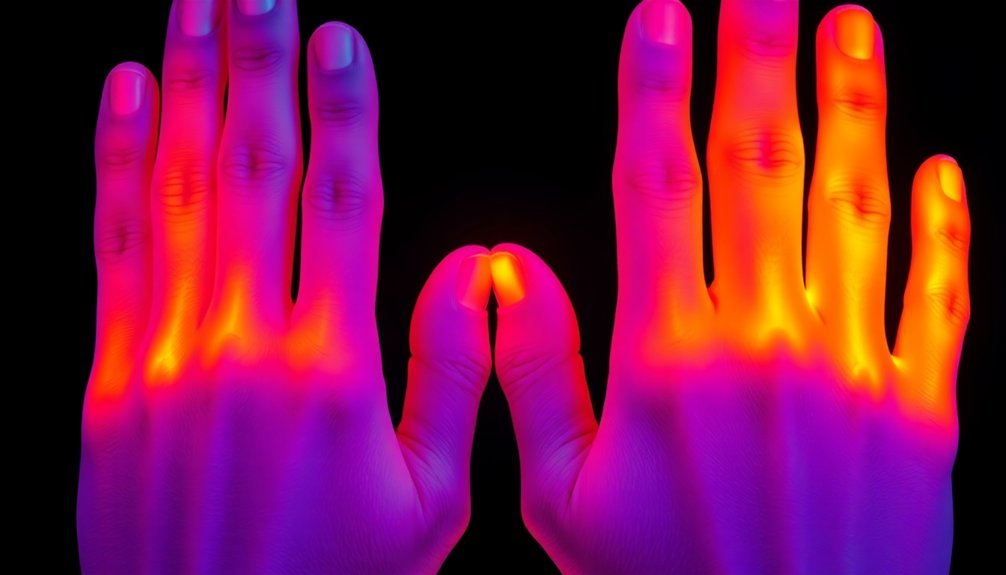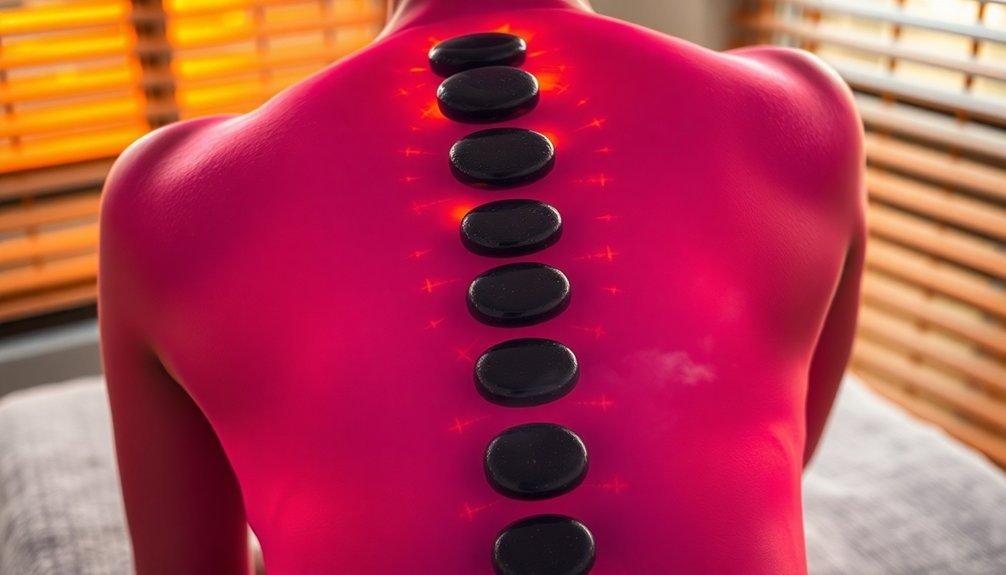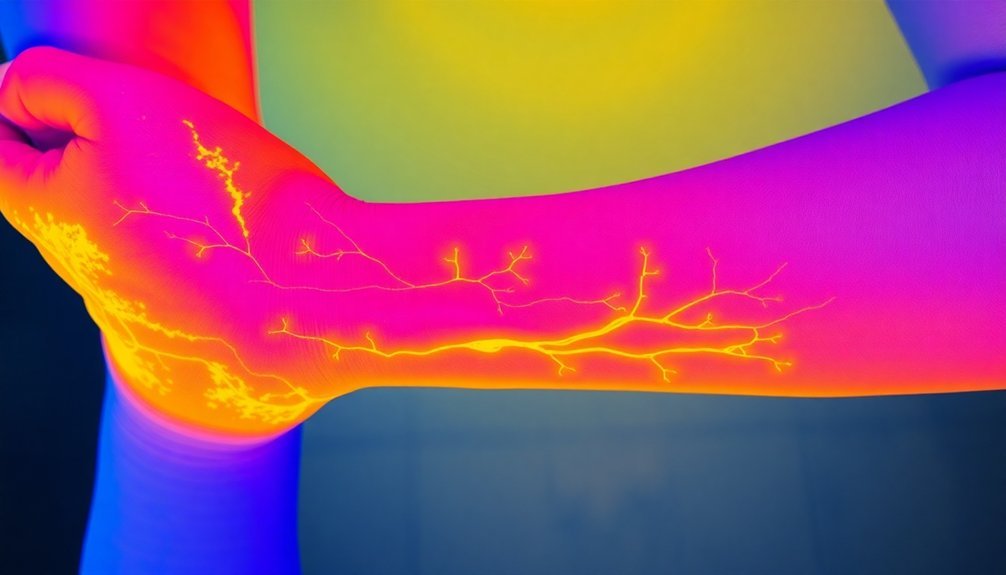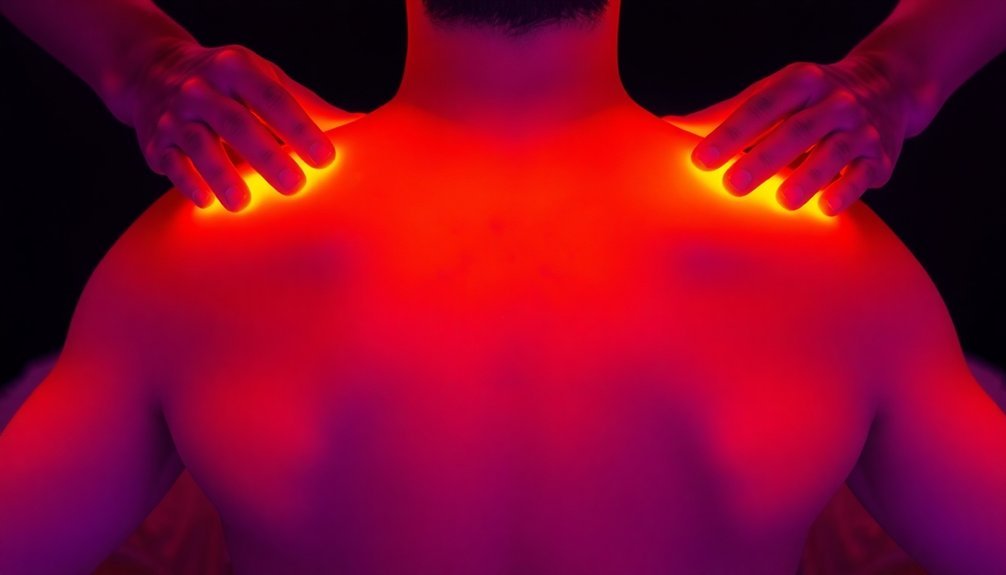Heat therapy naturally amplifies your blood circulation through five key mechanisms. You'll experience expanded blood vessels as warmth triggers your body to increase vessel diameter. Your heart pumps more efficiently, similar to during moderate exercise, while your blood pressure drops as circulation improves. The heat also reduces resistance in your blood vessels, allowing blood to flow more freely throughout your body. Most importantly, your peripheral circulation gets a significant boost, delivering more oxygen and nutrients to your extremities. Discover how these powerful effects can transform your cardiovascular health with proper heat therapy techniques.
Boosting Peripheral Blood Circulation

Three key aspects make heat therapy an effective solution for boosting peripheral blood circulation.
First, it directly improves vascular function by causing vasodilation, which increases your blood vessels' diameter and enhances blood flow to peripheral tissues. Regular application can help reduce tingling and numbness in your extremities. You'll experience better oxygen and nutrient delivery throughout your body, particularly in areas affected by poor circulation.
Second, heat therapy reduces arterial stiffness and improves endothelial function, making it especially beneficial if you're dealing with Peripheral Artery Disease (PAD). You'll notice enhanced walking performance and reduced systolic blood pressure, while your body shows decreased levels of endothelin-1, a marker of vascular dysfunction.
Finally, you can easily apply heat therapy through various methods. Try using warm compresses or heating pads for 15-20 minutes, up to three times daily, maintaining temperatures between 92-100°F. Remember to protect your skin by using a towel as a barrier and monitoring the temperature carefully.
For the best results, combine heat therapy with lifestyle modifications and consult your healthcare provider, particularly if you have underlying conditions. You'll find this approach can be as effective as supervised exercise therapy for improving peripheral circulation.
Opening Up Blood Vessels
The science behind heat therapy's effectiveness lies in its direct impact on blood vessel dilation. When you apply heat to your body, it triggers thermoreceptors that signal your blood vessels to expand, a process called vasodilation. This natural response allows more blood to flow through your vessels, delivering essential oxygen and nutrients to your tissues.
You'll get the best results by using moist heat, which penetrates deeper and works faster than dry heat. Whether you're soaking in a warm bath or applying a heated compress, the warmth stimulates the release of bradykinin, a compound that increases blood vessel permeability and promotes circulation. Deep breathing exercises during heat therapy sessions can enhance relaxation and further improve blood flow.
For maximum benefits, keep your heat therapy sessions to 20 minutes or less, up to three times daily.
It's vital to maintain a comfortable, non-painful temperature during treatment. Your body's blood vessels will respond most effectively to gentle warmth rather than excessive heat, which can damage tissues.
If you're dealing with specific circulation issues like peripheral artery disease, heat therapy can be particularly beneficial, but always consult your healthcare provider first to confirm it's suitable for your condition.
Improving Heart Function

Improving your heart's performance through heat therapy offers multiple cardiovascular benefits backed by scientific research. When you engage in regular sauna sessions, your heart responds by pumping blood more efficiently while strengthening your entire cardiovascular system.
Your arteries become more flexible, reducing stiffness and improving blood flow throughout your body. Studies show that a single 30-minute sauna session can significantly lower both systolic and diastolic blood pressure.
- Your cardiac output increases during heat therapy sessions, similar to the effects of moderate exercise, as your body works to cool itself down.
- Your endothelial function improves, helping blood vessels dilate properly and reducing your risk of cardiovascular disease.
- Your autonomic nervous system function enhances, leading to better heart rate variability and overall cardiovascular health.
The benefits extend beyond just the immediate effects of heat exposure. Regular heat therapy sessions can lead to long-term improvements in your vascular function, including reduced arterial stiffness and enhanced blood flow.
Your body's response to heat therapy triggers beneficial hormonal changes that support heart health, while the improved endothelial function helps maintain healthy blood pressure levels and reduces cardiovascular risk factors over time.
Lowering Blood Pressure
Research-backed heat therapy offers a promising approach to managing blood pressure naturally. When you apply controlled heat to specific areas of your body, it causes your blood vessels to dilate, increasing blood flow and reducing pressure throughout your system.
Studies show that heat therapy can lower systolic blood pressure by up to 30 mmHg over a four-hour period. In a study of patients with autonomic failure, overnight heat application demonstrated significant therapeutic effects.
You'll find several effective methods to harness heat's blood pressure-lowering benefits. Medical-grade heating devices, warm baths, or leg baths at temperatures between 100-104°F can trigger the necessary vasodilation response. Your body responds by redistributing blood to surface vessels, which helps decrease central blood pressure and improves endothelial function.
The evidence is particularly compelling for specific conditions. If you're dealing with autonomic failure or supine hypertension, heat therapy might offer significant relief. Studies from Vanderbilt and UNTHSC have demonstrated positive results, especially in older women who haven't responded well to traditional medications.
While heat therapy shows promise, you'll want to approach it carefully – controlled temperatures and proper medical supervision are essential, as excessive heat stress can increase cardiovascular risks.
Reducing Blood Flow Resistance

Resistance within blood vessels plays a crucial role in your cardiovascular health, and heat therapy offers effective ways to reduce it. When you expose your body to heat, your blood vessels dilate, creating wider pathways for blood flow and reducing overall resistance. This process activates thermoreceptors in your skin, triggering the release of important compounds like bradykinin, histamine, and prostaglandins that help relax your blood vessel walls.
Heat therapy's impact on blood flow resistance goes beyond simple dilation. You'll experience several key benefits:
- Heat shock proteins protect your blood vessels by preventing plaque buildup and reducing muscle wall thickening
- Enhanced vascular remodeling occurs due to beneficial shear patterns in your blood vessels
- Improved endothelial function leads to better flow-mediated dilation
Your body's response to heat includes increased metabolic activity in your tissues, which further reduces resistance to blood flow. This combination of effects makes heat therapy particularly valuable for conditions like peripheral artery disease and Raynaud's phenomenon. Through regular heat therapy sessions, you'll support your cardiovascular system's health while improving microvascular function throughout your body.
Frequently Asked Questions
How Long Should I Use Heat Therapy to See Improvements in Circulation?
You'll notice improved circulation after applying heat for 15-30 minutes per session. Keep sessions under 20 minutes and limit to three times daily, with hour-long breaks between treatments for optimum results.
Can I Combine Heat Therapy With Other Treatments for Better Results?
Yes, you can combine heat therapy with other treatments for enhanced results. Try pairing it with cold therapy, physical therapy, reflexology, or chiropractic care to improve circulation, reduce pain, and speed up healing.
What Temperature Is Most Effective for Therapeutic Heat Exposure?
You'll get the best therapeutic heat benefits between 40°C to 45°C (104°F to 113°F). For ideal results, aim for 42°C to 45°C when targeting deep tissue, while 40°C works well for superficial treatment.
Are There Specific Times of Day Best for Heat Therapy?
You'll get maximum benefits from heat therapy in the late afternoon when your body temperature peaks naturally. Morning sessions can boost energy, while evening treatments may help you relax before bed.
Which Heat Therapy Method Works Fastest: Sauna, Hot Bath, or Heating Pad?
Hot baths work fastest to increase your blood flow due to moist heat's superior penetration. You'll get quicker results from a bath than a sauna or heating pad, with effects noticeable in less time.
In Summary
You'll find that regular heat therapy can dramatically improve your cardiovascular health in multiple ways. By incorporating heat treatments into your wellness routine, you're naturally enhancing blood flow, optimizing heart function, and promoting better circulation throughout your body. Whether you choose saunas, hot baths, or heating pads, you're giving your circulatory system the boost it needs for better overall health.





Leave a Reply